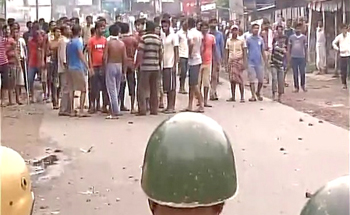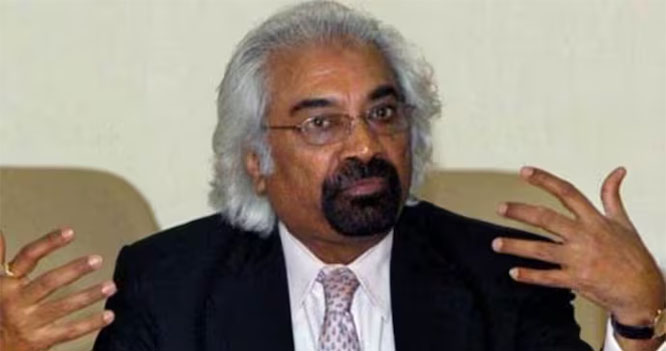Kolkata, Jul 7: Life was limping back to normalcy in the communal violence-hit areas of West Bengal's North 24 Parganas district as paramilitary forces marched on the streets, and internet and WI-FI services remained suspended in the affected pockets on Thursday.

There were no reports of violence from Baduria, Banstala and Tetulia -- the worst affected areas in Basirhat sub-division, where some roadside shops opened and public transport commenced plying. Train services on the Sealdah-Basirhat line, which were disrupted over the past two days due to blockades, also normalised, a railway spokesman said.
However, a clash broke out between supporters of the ruling Trinamool Congress and BJP-RSS activists outside a government-run hospital here following the death of an injured patient from Basirhat earlier in the day.
The BJP and RSS leadership claimed the deceased - an active BJP worker - was killed, allegedly during the communal trouble.
A police officer said the Basirhat resident died due to multiple stab injuries, but did not confirm it was linked to the communal violence.
Some BJP leaders including actor turned politician Locket Chatterjee were stopped by a mob from entering the hospital to meet his family.
Later in the day, a mob surrounded the cars of state BJP president Dilip Ghosh and party's national General Secretary Kailash Vijayvargiya and demanded they go back from the place.
Claiming the agitators were "Trinamool-backed hooligans", Ghosh said they were being forcibly stopped from meeting the deceased's family and some of their activists were "severely beaten up".
Police said a scuffle had broken out between the Trinamool and BJP-RSS activists. "The car of former BJP MLA Shamik Bhattachary was vandalised. No case has been lodged yet. No one has been detained," said a police officer.
Meanwhile, BJP chief Amit Shah formed a three-member delegation of MPs to look into incidents of communal violence in the state.
The delegation, headed by senior party leader Om Mathur, and comprising New Delhi MP Meenakshi Lekhi and Baghpat MP Satyapal Singh, will visit the violence-hit areas on Friday to take stock of the ground situation.
The Left and the Congress also decided to send teams to the areas on Friday. The Left delegation would be led by politburo member Mohammad Salim, while state Congress president Adhir Ranjan Chowdhury would spearhead the party delegatrion.
Amid the hectic political activity, the two-day old stand-off - in the aftermath of the violence - between Governor Keshri Nath Tripathi and the Mamata Banerjee government took a fresh twist with a senior state BJP leader calling him a "dedicated soldier" of Prime Minister Narendra Modi's brigade.
"Trinamool Congress thinks that bad-mouthing the Governor would bottle him up. But they are making a mistake here. He is a dedicated soldier of the 'Modi Vahini'. So, he will keep walking the path of truth," BJP national Secretary and former state President Rahul Sinha told reporters here.
The Trinamool was quick to latch on to Sinha's comments.
"There is nothing left to be said. He is the ignorant chief of an ignorant group," State Education Minister Partha Chatterjee said about Tripathi.
"Today, the cat is out of the bag. We've been saying for the last few days that the Governor's house has been transformed into a BJP office and the Governor himself is involved in the process. The statement of Rahul Sinha officially certifies our claims," he added.
Rushing in to control the political fall-out of Sinha's remarks, Vijayvargiya said no one should doubt Tripathi's potential and scholarship, and accused the state government of attacking the Governor to divert people's attention from their failure in maintaining law and order.
In Basirhat, the roads were mostly deserted and the few locals who came out on the road said they wanted peace to be restored in the affected areas.
"We all want peace to be restored. People of all communities have been staying together for ages here. We want things to be that way," a pedestrian said while talking to a news channel.
"No fresh incidents of violence have been reported. There are enough police personnel and security forces deployed to avert any untoward situation," a Baduria police station officer said.
Armed paramilitary personnel were seen marching on the streets while a large number of state police personnel kept vigil at check posts and pickets.
Clashes had broken out after a Facebook post by a local youth went viral earlier this week.
Though the youth was arrested and the post deleted, trouble broke out and spread to several areas as trees were felled to put up road blockades, vehicles, including those of the police, torched and houses and shops damaged.
A number of police personnel sustained injuries during the clashes.
The central government has rushed 300 paramilitary personnel to control the situation.








Comments
Add new comment